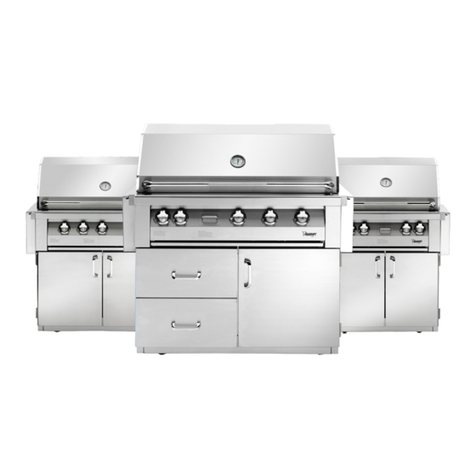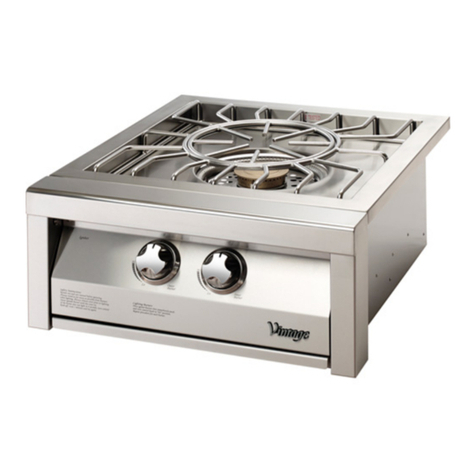
Page 4
Basic Rules
When using this appliance, for safety, READ all rules carefully and check local codes.
Basic safety practices must be followed, including the following:
•
Begin by ensuring proper assembly. A qualified technician should perform all otherservice.
•
Do not repair or replace any part of the grill unless specifically recommended in this manual. All other service
should be referred to a qualified technician.
•
For personal safety, wear proper apparel. Loose fitting garments or sleeves should never be worn while using
this appliance. Some synthetic fabrics are highly flammable and should not be worn while cooking. Never let
clothing, pot holders or other flammable materials come in contact with or too close to any grate, burner or
hot surface until it has cooled. Fabric may ignite and result in personal injury.
•
Use only dry potholders: moist or damp potholders on hot surfaces may cause burns from steam. Do not usea towel or
bulky cloth in place of potholders. Do not let potholders touch hot portions of the grill rack.
•
Grease is highly flammable. Allow hot grease to cool down before attempting to handle it. Clean grease tray
often so that grease does not accumulate and stay in it.
•
Do not use aluminum foil to line the grill racks or grill bottom, nor to line the drip tray. This can severely
upset combustion airflow or trap excessive heat in the control area. The result of this can be melted
knobs, igniters and increased chance of personal injury.
•
Never grill without the drip pan in place and pushed all the way to the back of the grill. Without the drippan, hot
grease can leak downward creating a fire or explosion hazard.
•
Children should be carefully supervised when they are in the vicinity of the grill. Do not allow them to get
close while in use. Items of interest to children should not be stored in or around the grill in the cabinet or in
the masonry enclosure. Portions of the grill can be extremely hot while in use and can cause severeburns.
•
Only certain types of glass, heatproof glass ceramic, earthenware, or other glazed utensils are suitable for grill
use. Use of these types of materials may break with sudden temperature changes. Use only on low or medium
heat settings according to the manufacturer's directions.
•
Do not heat unopened food containers as a build-up of pressure may cause the container toburst.
•
Protect your hand with a glove or mitt when opening and operating the grill. Open grill lid slowly to allow
heat and smoke to escape before fully opening.
•
Never lean over an open grill. When lighting a burner, always pay close attention to what you are doing.Be
certain you are depressing the correct igniter button labeled for the burner you intend onusing.
•
When using the grill: do not touch the grill rack, burner grate, hood or immediate surrounding area as these
areas become extremely hot and could cause burns. Use only the handles and knobs provided for operation of
the grill.
•
For proper lighting and performance of the burners keep the ports clean. It is necessary to clean them
periodically for optimum performance. The burners will only operate in one position and must be
mounted correctly for safe operation.
•
Clean the grill with caution. Avoid steam burns; do not use a wet sponge or cloth to clean the grill while itis
hot. Some cleaners produce noxious fumes or can ignite if applied to a hotsurface.
•
Insect Warning - Spiders and insects can nest in the burners of this or any other grill, and cause the gas to flow
from the front of the burner. This is a very dangerous condition, which can cause a fire to occur behind the
valve panel, thereby damaging the grill and making it unsafe to operate. Inspect the grill at least twice ayear.
•
Be sure all grill controls are turned off and the grill is cool before using any type of aerosol cleaner onor around the
grill. The chemical that produces the spraying action could, in the presence of heat, ignite or cause metal parts to
corrode.
When properly cared for, your VINTAGE Grill will give safe, reliable service for many
years. However, extreme care must be used since the grill produces intense heat, which can
increase accident potential.


































